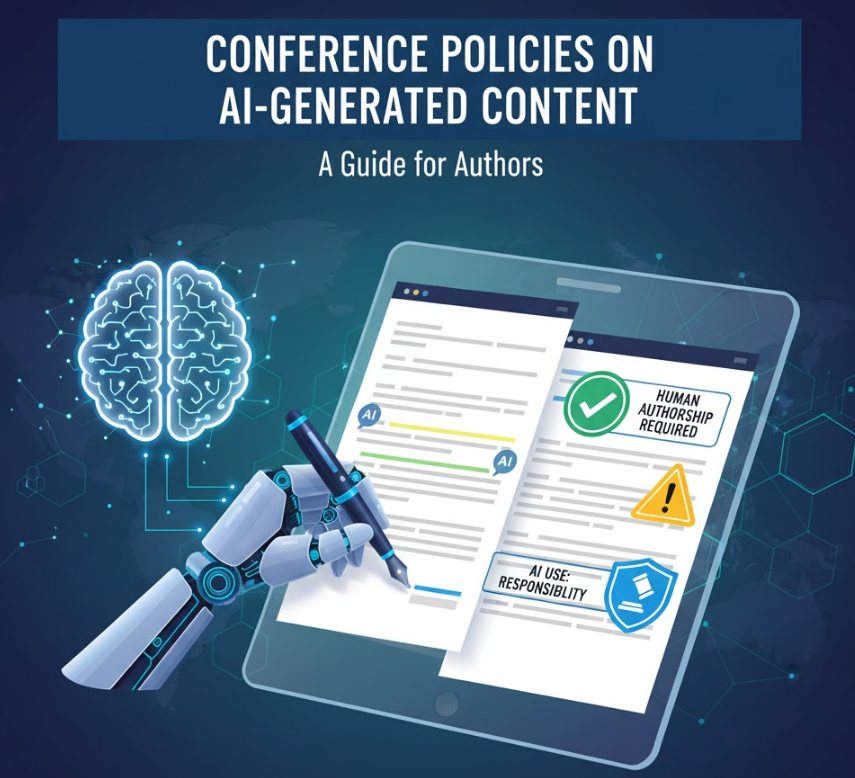

210 views||Release time: Oct 24, 2025
Artificial intelligence (AI) writing tools like ChatGPT, Google Gemini, and others have become incredibly powerful, offering assistance with everything from grammar checks to drafting entire sections of text. For researchers preparing conference papers, these tools present both opportunities and significant ethical challenges.
As conference organizers and academic publishers grapple with this new technology, policies are emerging. Understanding these rules is crucial to avoid accidental plagiarism or academic misconduct. So, what are the current policies on using AI-generated content in conference submissions?
While specific rules vary between conferences and publishers (like IEEE, ACM, Springer), a clear consensus is forming around several key principles.

Conference organizers and publishers need to ensure the integrity and originality of the research presented. AI-generated content raises several fundamental concerns:
Authorship and Accountability: Who is the author? An AI cannot take responsibility for the accuracy, validity, and ethical considerations of the research. Human authors must be accountable.
Plagiarism and Originality: AI models are trained on vast datasets, including existing literature. They can inadvertently generate text that is highly similar or identical to existing sources without proper attribution, leading to plagiarism. Furthermore, is the generated text truly the author's original contribution?
Accuracy and "Hallucinations": AI tools can confidently state incorrect information or even invent non-existent facts and citations (known as "hallucinations"). Submitting work containing such errors undermines the scientific record.
Based on guidelines from major publishers and academic bodies, here are the most common rules you'll encounter:
1. AI Cannot Be Listed as an Author This is the most universal rule. Major publishers like IEEE, Springer Nature, Elsevier, and ACM have explicitly stated that AI tools cannot be listed as co-authors on a paper. Authorship is reserved for individuals who make significant intellectual contributions and can take responsibility for the content.
2. Disclosure of AI Use is Often Required Transparency is key. Many conferences and journals now require authors to disclose if and how they used AI writing tools in the preparation of their manuscript. This disclosure might be required in the cover letter, the acknowledgments section, or a dedicated methodology section.
What to disclose: Typically, you need to state which AI tool was used (e.g., ChatGPT 4.0) and for what specific purpose (e.g., "to improve grammar and clarity," "to generate an initial draft outline," "to assist with paraphrasing").
3. Authors Are Fully Responsible for All Content Regardless of whether AI was used, the human authors are fully responsible for the accuracy, integrity, and originality of the entire manuscript. This includes:
Fact-checking any information provided by the AI.
Verifying all citations (AI tools often invent references).
Ensuring the work is free from plagiarism.
Confirming that the core ideas, analysis, and conclusions are the authors' own intellectual contribution.
4. Restrictions on Using AI for Peer Review Confidentiality is paramount in peer review. Using AI tools to analyze or write reviews of submitted manuscripts is generally considered a breach of confidentiality and is often explicitly forbidden.
Policies often differentiate based on how AI is used:
Generally Acceptable (Often Without Disclosure): Using AI for basic grammar checks, spelling corrections, or finding alternative phrasing (like a thesaurus).
Use with Caution (Disclosure Usually Required): Using AI to significantly rephrase text (paraphrase), generate an outline, check code, or improve language flow for non-native speakers. The core ideas must remain the author's.
Generally Unacceptable (Academic Misconduct): Using AI to write entire sections (introduction, results, discussion), generate core ideas or hypotheses, create data, or produce text that is submitted with minimal or no human editing and presented as original work. Using AI-generated images without proper disclosure and licensing is also problematic.
Always check the official guidelines. Do not assume. Look for policies in these places:
The Conference Website: Check the "Call for Papers," "Author Instructions," or "Submission Guidelines" pages.
The Publisher's Guidelines: If the conference proceedings are published by a major publisher (IEEE, ACM, Springer, etc.), check the publisher's general policies on AI in authorship and ethics.
Contact the Organizers: If the policy is unclear, email the conference chairs or organizers directly to ask for clarification before you submit.
Conclusion
AI writing tools can be valuable assistants for improving the quality and clarity of your academic writing. However, they cannot replace the critical thinking, original research, and intellectual responsibility required for scholarly work. The key principles are transparency (disclosure) and accountability (human responsibility). Always verify the specific policies of the conference you are submitting to and use AI ethically as a tool to support, not replace, your own intellectual contribution.